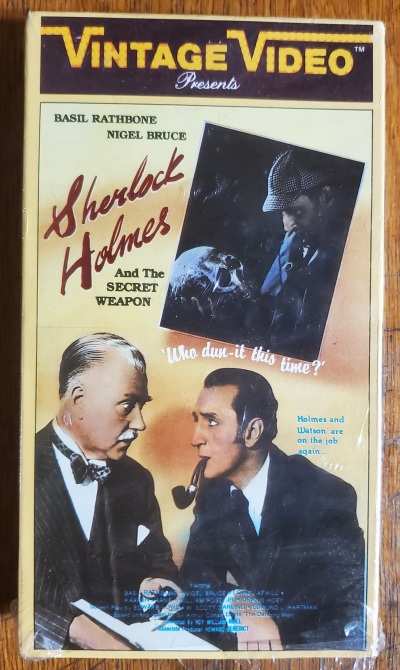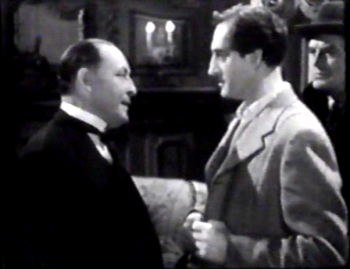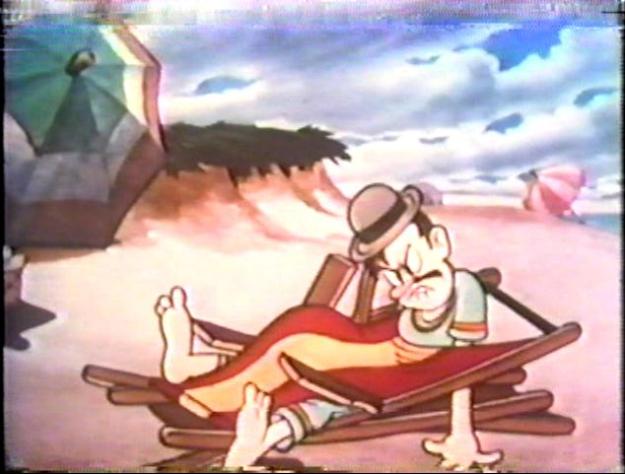Over the last two or three years, I’ve found myself really getting into the classic mystery (read: whodunit) films. Not that I had never watched them before or didn’t have any in my collection; I had and I did. But as you may or may not have surmised while looking at my dumb blog, my tastes have traditionally (but not exclusively) leaned towards classic horror & sci-fi. (Well, and b-westerns, too.) The sad fact of the matter is whodunit flicks had been woefully neglected for much of my movie-watchin’ life.
While I still love the stuff that has mostly been my bread & butter, as I’ve grown older I’ve also progressively grown to appreciate an absorbing mys’try flick. Charlie Chan, Mr. Wong, Bulldog Drummond, lay ’em on me mama. (Nearly a year ago, we took a look at an old Dick Tracy film, but I tend to think of those movies more as crime thrillers than full-fledged whodunits – though ultimately in the same wheelhouse.)
Anyway, Sherlock Holmes. The name is practically synonymous with “whodunit.” I haven’t read any of Sir Arthur Conan Doyle’s original stories, but I’ve certainly gotten into films based on the character. Well, classic films. Well, the Basil Rathbone series, at least. I have no idea which cinematic version of the character purists consider definitive, but I think it’s safe to say that in the general public consciousness, Rathbone’s rendition is the one that immediately comes to mind. We’re talkin’ iconic here.
And that brings us to or subject today.
Four of the films in the Rathbone series have long been delightfully public domain, and while my current probable-favorite in the series (The House of Fear) isn’t one of them, there’s still good stuff to be had. And even more fun is the smorgasbord of budget releases these now-PD entries have enjoyed over the years. And that brings us to our subject today. (Wait, I already said that.)
1942’s Sherlock Holmes and the Secret Weapon is the earliest of the series to go public domain, though luckily in regards to this review, it’s one I hadn’t seen prior.
Wacky Fact: I picked up a terrific two-disc DVD set at the dollar store some months back that included all four PD Rathbone flicks, other vintage, presumably-PD Holmes movies, and a load of episodes from the 1950s TV series. I had the ‘movies’ disc loaded up for quite awhile, but as is my wont, aside from a quick looksee, I never got around to actually watching any of it before it got swapped out for something else. Not that I can’t load it back up again when the mood strikes me, of course, and if nothing else, the four Rathbone flicks were more than worth the price of admission alone.

Who dun-it this time? Why, Vintage Video, of course!
My unintended hesitation turned out to be fortuitous though, because when this particular home video release turned up for sale online and I duly slammed my meaty paws on the “BUY DIS” button, I got to go into it fresh. Once the tape arrived and I found the time/drive to sit down and watch it, I mean.
As you can see, we are once again taking a trip into the world of Vintage Video/Amvest VHS. A cursory glance through the contents of this site will quickly show how fond I am of this label. Certainly we’ve looked at their Grampa Al Lewis series multiple times, but our subject today is more in line with one of their ‘regular’ releases, which we’ve also seen before. (In other words, no, Al Lewis doesn’t host Holmes here, though that would have been pretty baller.)
I’m a real sucker for tapes from this manufacturer, even though they (mostly) dealt with the same public domain movies multiple budget outfits during the home video boom of the 1980s dealt with. Certainly this all stems from the aforementioned Grampa series, but there’s also the sometimes-unique cover art, sometimes-interesting prints used, and frankly, the relative-obscurity the releases as a whole share. (They tend to be scarce – maybe one or two copies for every, I don’t know, twenty comparable releases from Goodtimes – though they’re not particularly valuable. This copy here, the first I’d ever seen, was mega cheap – and still sealed, to boot.)
‘Course, you kinda need an affinity for VHS and budget home video and whatnot to appreciate all this (growing up with it all probably helps, too), because technically, this is pretty superfluous to have in the day and age. We’ve got DVD and Blu-ray and innernet streamin’ and all that, and when the movie in question has long been in the public domain, from a practicality standpoint, there’s really no reason to get so stoked over something like this.
Except that with the right mindset, there is: forget picture quality and bulkiness and ease of use – it’s all about taking a trip back in time here. Are there better ways to watch this movie? Well, yeah. But this here, it’s like holding a piece of a bygone era in home video in your hands – which of course is exactly what is indeed happening. Necessary? Naw. A trip back in time? Well, yeh. (Or so says I, and as we all know, my word is of tantamount importance.)
I like the cover art here; certainly it’s in the 1980s budget video release tradition, but that’s perfect for our purposes today. A good many of these VV/Amvest tapes, at least earlier ones (1985, as opposed to 1988 and beyond) simply used original poster art, usually (but not always) bordered with the VV banner you’re seeing here. There could be some modifications to the original artwork, but for the most part, it was still ultimately, you know, the original poster art. However, the tapes I find especially interesting in this particular arena are the ones that used original, or at least more original, motifs. Such is our case here: sure, they just used stock photos of Rathbone’s Holmes (along with Nigel Bruce’s Dr. Watson), but the watercolor (?) filtering (?) of them coupled with the unique title font (and slightly silly “Who dun-it this time?” tagline) intrigues your pal me. Also, dig the credits at the bottom of the cover, you can’t really read ’em here but they seem to be mimicking those of a ‘big time’ video release, which is something I can’t really recall one of these VV tapes identically doing. Was there some then-recent Sherlock Holmes movie this was piggybacking on?
(Speaking of dates, the one found on the back of the box here was indeed 1985, but in the interest of full disclosure, the label on the tape itself was a newer one akin to what Amvest was using around 1988 or so. Thus, this was undoubtedly a later re-release, but since I don’t have an exact date otherwise, I’m sticking with ’85 here, as you can see in the article title above. Aw, it’s not like it really matters anyway…)
I don’t have much interesting to say about the back of the box, so what say we look at the movie proper now…

The opening image, such as it is.
Upon firing the tape up, I was treated to this: the credits already in progress, right from the very start. No title card, credits already rolling. Thaaaaaanks. Ah, budget tape tradition! I’m not going to go out of my way to track down another copy to see if they’re all like this (‘course, if I come across another one in-person during my travels…), but this begs the question: how does this even happen? Was it the way their “master tape” (whatever that constituted) was, or were they making copies tape-by-tape and this was a goof they didn’t notice or just didn’t feel like correcting? It’s kinda funny, but also kinda irritating. Then again, this sort of thing wasn’t totally uncommon with budget video releases, and it’s not even the first time I’ve run into the opening/closing parts of whatever being MIA with VV/Amvest. It is what it is.
Our plot: Holmes has been enlisted to protect one Dr. Tobel, who has created a new fancy schmancy bombsight to fight them Nazis with. As a precaution, he separates the bombsight into four pieces and entrusts them to four different scientists. For good measure, he notates who has what, but as a coded message involving “dancing men.” (Said code being the only part of this movie that was based upon an original Doyle story, apparently.)
Of course, rather than following Holmes’ simple directions and staying put, Tobel just has to slip out of protective custody to visit his fiancée (wimmins, amiright?), which promptly and naturally gets him abducted by baddies. The specific baddies in question? Holmes’ arch-nemesis Professor Moriarty and his cohorts, that’s who! Turns out Moriarty is in league with the Nazis; selling them the bombsight would be very lucrative, as you may well imagine. This is undesirable to say the least, so now Holmes must rescue Tobel, recover the four pieces of the bombsight, and thwart Moriarty (and by extension, the Nazis), for the time being at least.

Holmes facing off against Moriarty (or rather, from left to right, Moriarty facing off against Holmes).
Wait, Nazis? Say what?! It’s true; this is a WWII-era Sherlock Holmes adventure! Y’see, 20th Century Fox produced the first two entries in the Rathbone Holmes series, and they were in the natural Victorian setting. But afterwards, Universal picked up the series, turned them into b-movies, and placed them in a then-modern wartime setting. (Supposedly with an explanatory “Sherlock Holmes is timeless” or something along those lines; I haven’t seen that first Universal effort. Secret Weapon here was the second.) It’s pretty unexpected, and really, to be frank, pretty awesome. I mean, it’s Sherlock Holmes, fightin’ Nazis! Unless you’re a purist’s purist, you can’t not love that! I haven’t seen every entry in the Rathbone Holmes series, but I sure hope there’s a scene where he decks Hitler at some point, not unlike that crowd pleasing moment in Zone Troopers. “Did I just engage Adolph in fisticuffs?” “You sure did, my good chap!”
Not gonna lie: this is some good stuff right here. You’ve got Basil Rathbone as Sherlock Holmes, which automatically makes things worthwhile, but then you add a WWII setting and a breezy, b-movie sheen over top of all of it, no jivin’, it’s just irresistible. The movie is more spy-ish than I was first anticipating, with Holmes’ disguising himself and going undercover more than once. And while I’m not sure I’d consider it a full-fledged whodunit (probably the only real sleuthing sleuthing is deciphering the code), it’s got some noirish elements, terrific acting (Basil Rathbone as Sherlock Holmes and Lionel Atwill as Moriarty? Plus Nigel Bruce’s ever-reliable Watson? Yes, please!), and even some gruesome elements (besides the obvious implications of the Nazis gaining the bombsight, at one point Moriarty attempts to slowly kill Holmes by draining his blood, drop by drop). I ain’t joshin’ you, this is a lot of fun. If you’re a sucker for wartime b-movie action like I am, Sherlock Holmes and the Secret Weapon is a must.
So, what kind of print did Vintage Video/Amvest/whoever utilize for this release? Their tapes could feature prints ranging from “okay” to “dragged around the parking lot multiple times.” Secret Weapon falls more towards the latter end of that spectrum. While the duplication itself was decent enough I guess, the print they got was, well, it was pretty wasted. It’s probably darker than it was intended to be, and there are a lot of film scratches, dust, dirt, debris, splices, what have you. There are some moments of really heavy wear, and while things seem to calm down somewhat as the film progresses, this probably isn’t the, uh, best the movie has ever looked.
Furthermore, the run time: the back of the box sez 70 minutes, the official run time I’m seeing online is supposedly 68 minutes, but the actual running time here is really about 56 minutes. So unless the missing part of those opening credits ran 11+ minutes (something tells me they didn’t/don’t), it’s a safe assumption this is an edited print. Cut for TV at some point? Really egregious splices? Something else? No idea.
But you know, none of that really bothers me. Okay, sure, if I’m paying for a big deluxe Blu-ray or something, I’d want the movie to look like Rathbone et al. are performing live right in front of me, inexplicably in grayscale, at that very moment. But this tape as it is, it presents the movie in a way that recalls countless trips through the projector, multiple runs on late night television over the decades, an old timey cinematic feeling, something along those lines. It’s part of the fun (at least in retrospect; it probably wasn’t a blast back then) of collecting these old school budget tapes: you never quite know what you’re going to get. Unlike today, where it seems like the same prints just keep getting shared over and over, copies could really vary from manufacturer to manufacturer back then.
Still, the complete opening credits would have been nice. And speaking of the credits, the final cast credits card is there, but cuts off really quickly, as if whoever couldn’t wait to be done with the whole thing. Of course the meat of the movie (i.e., the important stuff) is all there – such as it is I mean – but yeah, this really exemplifies the mid/late-1980s budget home video release ideal. (Ideal?)
So there you have it: Sherlock Holmes and the Secret Weapon, as presented by Vintage Video slash Amvest back in the 1980s. If you just want to see the movie (and seriously, it has my recommendation), that’s something that can be easily accomplished. Home video releases are numerous, but since it’s public domain, you can watch it free an’ legal online right now if you so desired! Would that be as much fun as taking an unnecessary trip back to the 1980s as I’ve done here? I’ll let you decide that aspect for yourself.
By the way, this wasn’t the only Rathbone Holmes VV put out: The Woman in Green and Terror by Night also saw releases on the label. (I couldn’t find Dressed to Kill, the last PD Rathbone Holmes as well as the last Rathbone Holmes period, via VV, but I wouldn’t be surprised if there was one of those out there, too.)
Oh hey, fun facts up in here: this post was first intended to be just as you’ve seen it now, but then I thought about three separate reviews over three days for the three VV releases, and then I thought about a single post spotlighting the triple bill, and then I considered four reviews over four consecutive days with Congress Video’s 1985 VHS release of Dressed to Kill filling out the fourth, and then as late as yesterday I considered a single post, double bill looking at just Secret Weapon and The Woman in Green, before simply going back to the original plan and giving Secret Weapon the sole spotlight. I enjoyed it so much, it deserves the space to itself.
Did I ultimately make the right decision? Well, we’re just going to have to live with the results, anyway.










